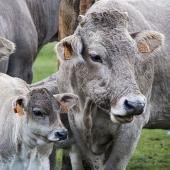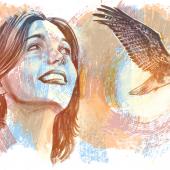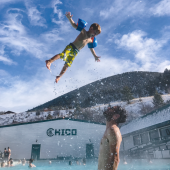Staying Winter Fit
As daylight in Montana shrinks and temperatures fall, we are reminded of our fragility as furless, warmth-loving creatures. Maybe as the first snowflakes fell you felt the irresistible lure of creature comforts: a fireplace and a wool blanket, paired with some hot cocoa and that novel you squirreled away all summer.
But as we know, all of that inertia, warmth, and ease is not sustainable from October to April (or… June?). Too much hibernation is not the key to enjoying the winter months, and worse, it’s not healthy. It can lead to boredom, isolation, loss of fitness, and depression. Yes, we know we must get out!
While recreating outdoors is good for physical and mental health, it comes with its own risks, many of which we can mitigate with a little foresight, fitness, and preparation. With a smorgasbord of activities just beckoning us—skiing, ice climbing, sledding, snowmobiling, snowshoeing, fat biking, skating, snowman building, ice sculpture carving, and more—it’s best to employ a few basic practices to ensure your season won’t be cut short by injury.
Below are a few of the most common injuries sustained during the winter months and a few guidelines on how to prevent them. After all, prevention is key.
Sprains, strains, and fractures
ACL tears: If you ski, you’ve probably heard of the anterior cruciate ligament (ACL). It’s a commonly injured ligament within the knee, and the reason many a ski bum opts to get health insurance. Excessive lateral rotation is the cause. For example, the tip of a ski gets snagged and pulled outward, twisting the knee. Many people hear a pop as the ligament snaps, and there may be pain and an unstable feeling when you try to bear weight. The tear can be partial or complete, and often requires surgery for those who value full knee function.
Tibia-fibula fractures: Aka “tib-fib” or “boot-top fractures”, these broken bones are also particularly common among skiers. They occur when the ski suddenly grinds to a halt but the body’s momentum (and consequently the lower leg), keep going. The outcome is that the bones break right at the top of the rigid ski boot, which acts as a splint for everything below.
To avoid: Don’t fall. Ha! If only it were that easy. But you can minimize your risk. First, stay fit year-round to avoid injury. A little soreness can be inevitable, but if you want to avoid a season on the sidelines, consider activity-specific training. The idea is to simulate the activity, gradually increasing duration and/or difficulty. Hamstring exercises can help to protect against ACL tears. Be creative and come up with your own exercises or consult with a pro. Remember that accidents often happen toward the end of the day, as our bodies tire and we start to mentally check out a bit. Also, be sure to start off your season slowly. For your first few days out so short spurts of the activity. Winter is long in Montana; you have time to build on your foundation. Your body will thank you.
Overuse injuries/tendinitis
While these are also musculoskeletal injuries, they are more insidious in their onset, and are likely to occur later in the season. Whether swinging your ice tool or planting your pole while skate skiing, certain repeated activities for weeks and months can cause inflamed and painful joints.
To avoid: Ensure you are using proper form via feedback from knowledgeable companions or instructors. Also, try to vary your movements as much as possible. Keep joints warm and strengthen them before the season starts, usually by working the muscles above and below the joint in question. Rest, ice, and analgesics are helpful if it’s too late.
Concussion
Any winter activities that involve high speed and/or a fall risk put you at risk for concussion, including, of course, snowmobiling. Concussion is a loose term, typically reserved for a mild head injury, but head injuries occur on a spectrum, and can certainly be lethal. Bear in mind, the only thing worse than bonking your head once is bonking it more than once. It is now understood that repeated concussions result in long-lasting consequences.
To avoid: Wear a helmet. As my ICU nurse friend says, “We can fix almost anything, but we can’t fix the brain.” Replace your helmet per the manufacturer’s instructions. Control your speed. Watch for out-of-control skiers, sledders, ice-fall and the like.
Hypothermia
Hypothermia occurs on a spectrum as the body’s core temperature drops below 95°F. It can be mild and easily reversed, or life threatening if severe.
To avoid: One word: layering. Bundling up too much right out of the gate can lead to sweating, and that moisture will inevitably cool on your skin. Avoid cottons, which retain moisture and set you up for a chilling effect. Okay, maybe one more word: fuel. Stoke the internal fire with plenty of calories and even though water may not sound tempting when you’re cold, it’s important to drink up if you’re being active. One trick is to carry a thermos of tea or hot cocoa instead of just cold water in your pack. For many activities, it may be well worth the extra weight. Keep and your friends refueled and up on their feet, exercising, and generating heat.
Frostbite
The freezing of flesh usually takes place in little body parts far away from the warm-blood-pumping heart, such as the fingers, toes and nose. Like with sunburns, the freezing process starts superficially and works inward, so frostbite can be superficial or deep.
To avoid: Again, hydration is important. Fluids will help increase blood volume, which means more warm, oxygen-rich blood coursing through the extremities. Our bodies shunt blood to the core when we are cold to (wisely) protect vital organs and prevent hypothermia, and our fingers and toes are the sacrifice. Make sure there’s enough fluid volume to go around and consider hand and toe warmers if you know you have poor circulation, Raynaud’s phenomenon, or other risk factors. Dry socks and gloves are a must. If you know you’ll be sweating a lot, bring a spare pair. Don’t tolerate numbness and always warm up your digits before any real damage is done. Repeated frostbite on the same body part can cause vascular damage, meaning less blood flow to the area in the future resulting in, you guessed it, greater risk of frostbite. Prevent, prevent, prevent.
The following are additional general guidelines to keep in mind this winter:
Plan ahead: As in any season, check the weather forecast, bring extra layers, pack plenty of snacks, water, and other appropriate supplies. Make sure everyone in your party does the same. It’s easy to forget sunglasses and sunscreen in the winter, but the snow is fiercely reflective. Snowblindness and sunburn are real dangers, especially at altitude. Remember the seven P’s: Prior Proper Planning Prevents Piss Poor Performance. Consider taking a course in Wilderness Medicine. Your friends will appreciate it, and you won’t regret it. Stay fit year-round and start slow with any physical activity that you haven’t done in months. Enjoy yourself. Be safe. Have fun!












Leave a Comment Here